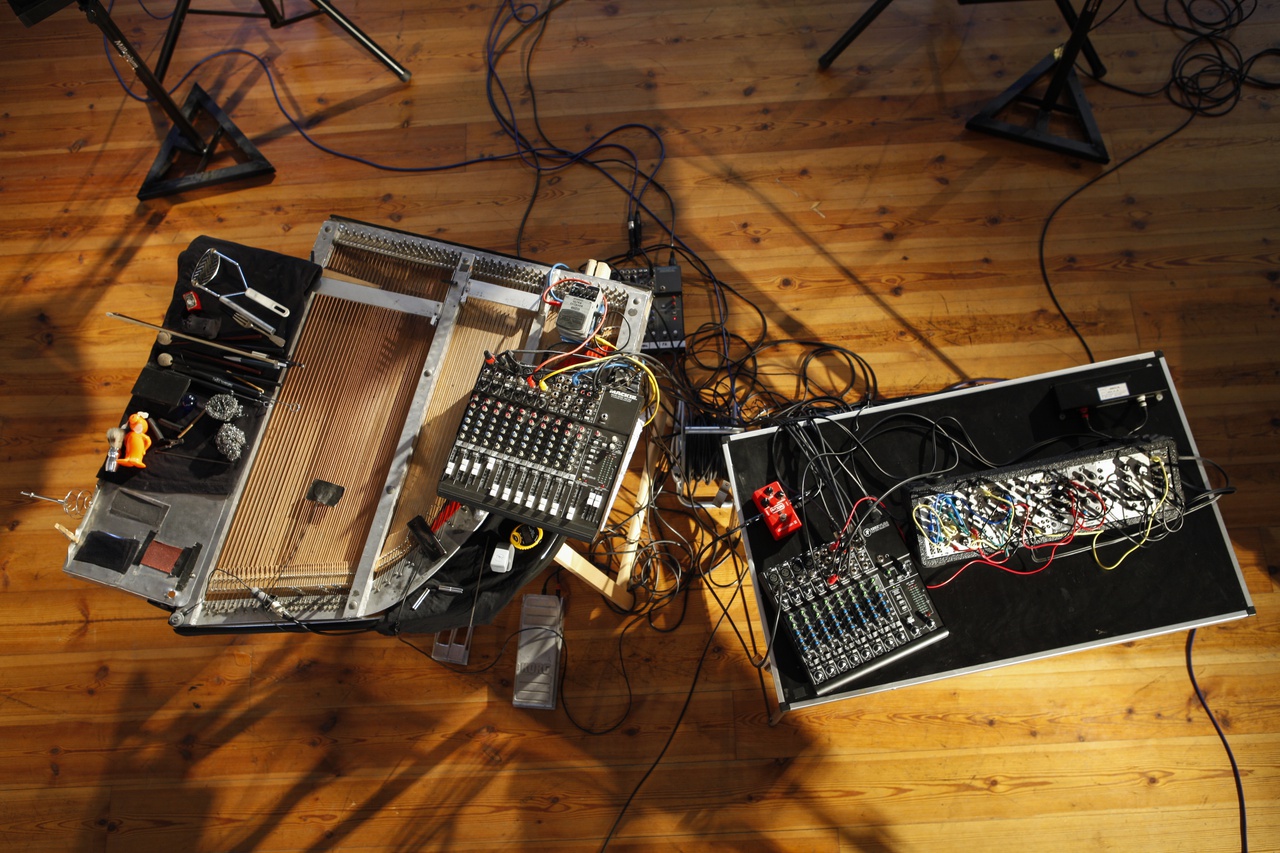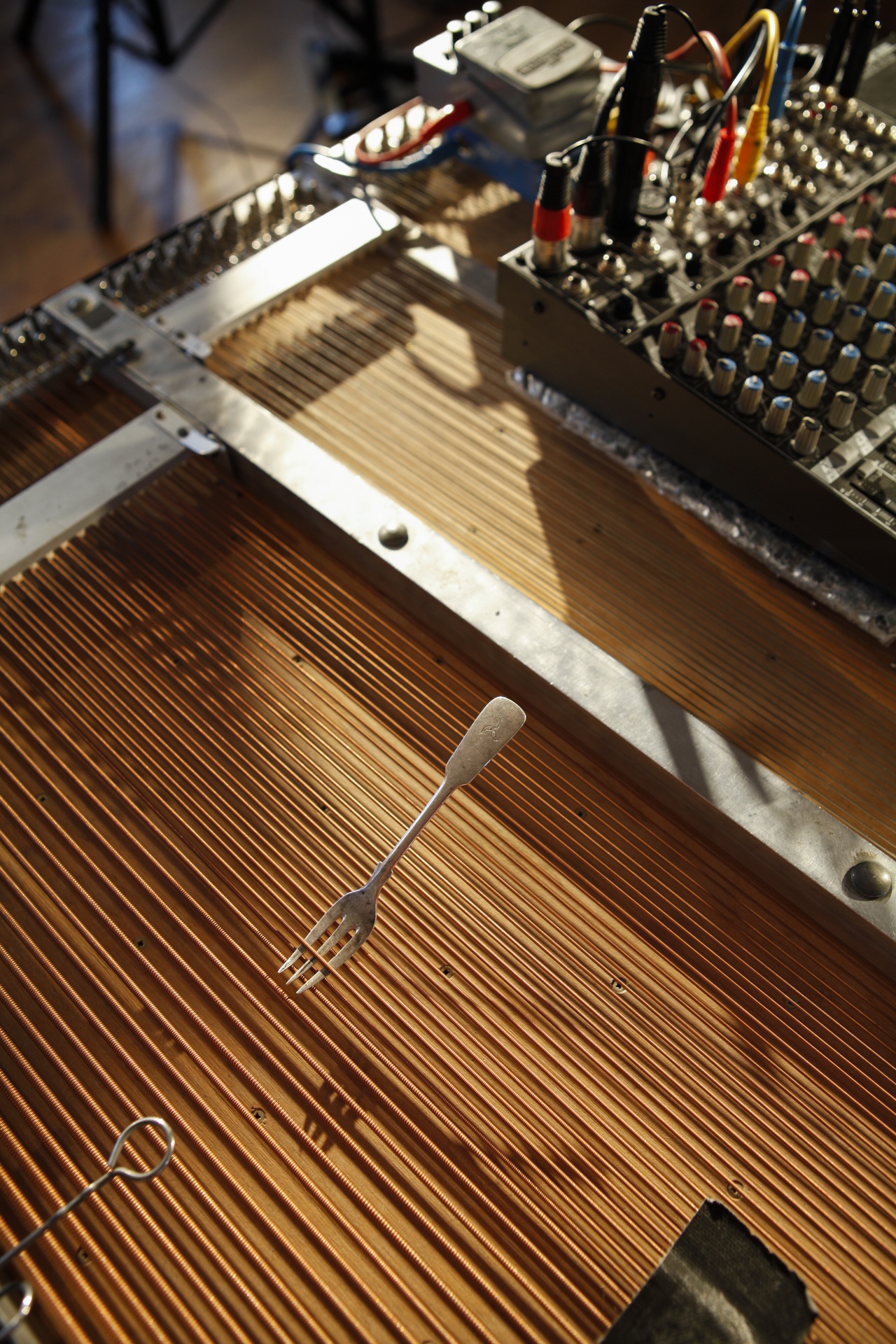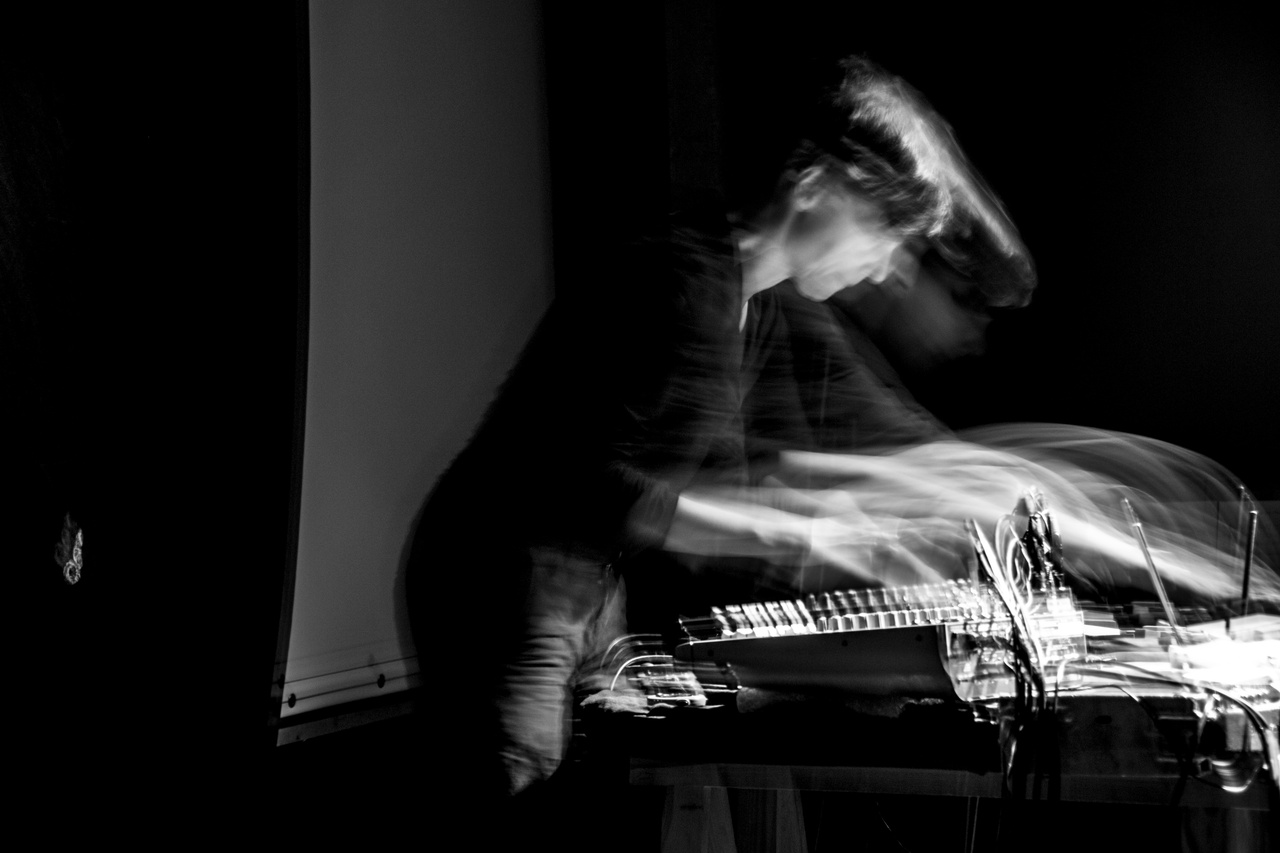Production by Subtraction

At a concert. It’s quiet. I can hear the heating. The ticking of a clock. Fabrics rubbing against one another. The clearing of throats. Feet shifting on the floor. Cars passing. Wind. A juxtaposition and interweaving of sounds of different frequencies, durations, intensities, directions, and distances.
This is how Berlin-based experimental composer and musician Andrea Neumann describes the setting for her performance, which continues in her text on the centrality of noise and silence for her work. For Neumann, the two sonic extremes belong very much together, and her unique approach to musical form requires that the two be present, always.
“Silence is not the absence of sound but the beginning of listening.” [1]
In the following pages, I will try to outline the principle of subtracting or omitting something to reveal something else as an overarching category, which I will use to describe and interpret three distinct stages in the evolution of my practice as an experimental musician:
1) The modification and transformation of a musical instrument – from piano to inside piano
2) The history of so-called Reductionism, a movement within the Berlin-based Echtzeitmusik (real-time music) scene
3) The development of a musical practice in which the instrument plays itself and the performer becomes a listener
1) From piano to inside piano
In the mid-1990s, as I was completing my training as a classical pianist, I started looking for my own language on the piano. Two experiences led me to abandon the keys and explore the sounds in the piano’s interior, on the strings, the tuning pins and bridge: Every key I struck as I sought to produce something unique or hitherto unknown came with associations of a composition for piano I had heard elsewhere or played myself. To my ears, the sound of the keystroke as such was fraught with the canonical piano literature – there was no escaping this effect. The other experience was that the sonic contour produced by the keys was largely invariable (keystroke – attack – decay), with no possibility of modulating the sound after striking a note, although the keystroke itself obviously allows for a wide spectrum of variations.
By preparing the piano, one can generate a wealth of modulable and non-decaying sounds in the instrument’s interior: by rubbing small bamboo rods wedged between strings; with magnets vibrating on the strings, or forks inserted between them; with percussion brushes sliding vertically or horizontally along strings or the bridge …
Once all my musical activities focused on the piano’s interior, I came to the realization that I no longer needed the rest of the instrument: it had become dispensable.
A piano workshop sold me a frame stripped of the wooden case, keyboard, and mechanics; its weight was impractical, and in 2000, Bernd Bittmann built a scaled-down and lighter aluminum version for me. To amplify the very faint sounds of this replica, I attached various contact microphones connected to a mixer console, discovering feedback internal to the device that added an electronic noise factor to the soundscapes I developed on the piano’s inner workings.
“… a shift away from music and toward sound, and, more important, from the symbolic and representational (music) to the phenomenal and nonrepresentational (noise).” [2]
This transformation of the harmonic-melodic piano with its fixed pitches resulted in the inside piano, a producer of sound and noise.
By deconstructing the piano, I had in a sense revived a tradition that goes back to the mid-20th century: the manifold assaults on the grand piano as a symbol of bourgeois high culture, which often culminated in its destruction.
“Bring a bale of hay and a bucket of water onto the stage for the piano to eat and drink. The performer may then feed the piano or leave it to eat by itself …” (La Monte Young, “Piano Piece for David Tudor #1,” 1960).
“Composition No. 3 Paint with orange paint patterns over the piano. Composition No. 6 Stretch the 3 highest strings with a tuning key until they break. Composition No. 7 Place one piano on top of another (one can be smaller).” (George Maciunas, “12 Piano Compositions for Nam June Paik,” 1962).

“Composition No. 13 Hammer all the keys on a piano down with nails.” [3]
Today’s audiences are still fascinated by this sort of performance. “Composition No. 13” was reenacted in 2007 to celebrate the fifth anniversary of ausland, an event venue in Berlin’s Prenzlauer Berg neighborhood. Al Hansen’s “Yoko Ono Piano Drop,” for which he dropped a piano from the fifth floor of a high-rise, has attracted numerous imitators for decades.
The development of the inside piano – stripping the piano down to the frame, soundboard, and strings – was in some way a similarly destructive act in which the instrument lost some of its musical potential. Still, throwing out the old was not my primary intention. Rather, I sought to “uncover” something new.
Subtracting essential characteristics of the piano allowed me to discover a soundscape with utterly new and different qualities.
I realized that noise consisted of self-contained entities that had a beauty all their own: the noise, for example, that is produced by very slowly sliding a contact microphone along the surface of copper-wrapped bass strings; or the interference tones generated when several strings tuned to microtonal intervals are excited by sine tones. The focus was less on a linear consistency of the sounds relative to one another – as in music based on tonal interrelations – than on the granular perception of everything that is “going on” inside of noises. I explored their internal structures.
“Acoustic microscopy is another term widely used to describe this phenomenon. Think of it like this: the magnifying glass used to be centered on the periodically oscillating pitch, but then it was shifted outward, toward the margins, toward the transient phenomena, the background noises, which were exposed and isolated and became the material people then started using to build something.” [4]
The individual sound as such became an event. Bringing out the full spectrum of its qualities, directing the focused attention to its details, required a frame. The ideal framing was not sound but silence. Silence is spacious, accommodating the imagination, an anticipatory ideation of what might happen in a moment. The non-occurrence of sound contains all possible subsequent events. The actual sound that then occurs emerges into a space that the listeners have helped create.
“Silence is always in a state of listening or of waiting for something to happen.” [5]
What could be better suited to calling attention to a sound then the silence surrounding it?!
2) Berlin Reductionism
Berlin in the 1990s was an ideal place for all sorts of currents within experimental music. Comparatively unconstrained by economic necessities and commercial pressures, musicians were free to break away from established styles to conduct research into new as well as old forms. Anorak (Dunckerstraße 14), then the main hub of the scene, was where noise, electronica, trash pop, free jazz, improvised and contemporary composed music, performance art, and sound art all came together.
One style that could be heard in many clubs in East Berlin was the European version of free jazz. It had evolved over the course of decades, spawning a wide range of subtly different variants, and was characterized by extremely high levels of energy, expressiveness, virtuoso skill, density, and dynamism – it was fast, loud, and high-pitched, sometimes resembling a wall of noise. Its relative dominance prompted the parallel development of an antithetical tendency, whose practitioners made music that turned those attributes on their head: quiet, eventless, with lots of rests, transparent, inexpressive, non-virtuosic (or certainly not by the standards of virtuoso performance in free jazz). Halting rather than in constant flow, a wall of silence rather than a wall of noise.
Where free jazz privileged the incessant flux of energy, this tendency focused attention on the quality of individual sounds, on when they began and when they ended, when a second sound blended in with the first and their concurrence modified them both. The faintest event might alter the entire musical structure, as in a mobile, where moving one element sets all other elements in motion. A feeling of “hearing and being heard” arose among the performers who made this music, a distinct sense that what they were doing had not only a musical but also a social dimension that contrasted with the way free music was often about the performers “struggling to be heard.”
The audience’s response to this quiet kind of music was sometimes no less “violent” than with extremely loud music. It agitates listeners, rebuffs their attempt to immerse themselves, provokes impatience and anger … Silence can act like a wall one runs one’s head against – it can be calming and unifying, sharpening the listeners’ sense for strange sounds (an effect that can linger after the concert), letting them experience a different kind of temporality and offering them a new way to experience themselves.
“In the gap between sounds, the silent space within music, listening is forced away from the musical object and toward its own process: what I hear is the noise of my own listening, where responsibility is given to the listener for the music produced.” [6]
Some people coined the term “stomach music,” because it was often so quiet that the noise made by people’s stomachs were the loudest sounds in the room. Others spoke of a “sacred” mood (Ulf Sievers: “At some point it became too sacred for my taste” [7] ) or an atmosphere of “tyranny” because the audience would notice the slightest movement and so listeners no longer dared to move. “Silence is a mirror that shows this formless subject to himself. … All sounds I hear include my own and I am always at the centre of all the sounds heard. Silence is the place of the ‘I’ in the listened-to world. However, this is not a confident, territorial ‘I’ but an ‘I’ in doubt about his position, for ever awkward about being in the middle of the ‘picture.’” [8]

Andrea Neumann
3) When the instrument plays itself, the performer becomes a listener ---------------------------------------------------------------------
“… from composer as writer to composer as listener …” [9]
The interplay between the inside piano and me is informed by my own sonic ideas and wishes on the one hand, and by what the instrument makes possible at the moment it is played on the other. The sounds developed in the acoustic research described in section 1) above defy exact reproduction. Minor changes in the placement of preparations, fluctuations of finger temperature and humidity, of the pressure exerted and the tempo affect the resulting sound and make each performance slightly different from the one before. This observation led me to the recognition that the inside piano has its own agenda, that it is a partner rather than an instrument.
“I understand this process of performative instrumentalization not to be a form of control but instead as creating an open and participatory environment in which the instrument or the device itself suggest specific ideas of their textures and in which the human body becomes acquainted with the ‘thing’ at hand by being able to test boundaries, negotiate subtleties and uncover certain threshold conditions …” [10]
From this perspective, I probed the instrument’s potentials, trying to find ways to make it produce sound autonomously for as long as possible with a minimum of outside input. Certain silver pastry forks vibrating between the strings develop a dynamic of their own that waxes and wanes before slowly fading away after around two to three minutes. Propellers and other motors set on the strings can produce drones for as long as the battery lasts. The fork sounds struck me as too brief, the propeller-on-string ones too static. In 2014, I adapted and reinterpreted George Brecht’s “Incidental Music Part 2” for the inside piano: “Wooden blocks./A single block is placed inside the piano. A block is placed upon this block, then a third upon the second, and so forth, singly, until at least one block falls from the column” (George Brecht, “Water Yam,” 1963). One phenomenon I noticed was that strings excited by a single event (in this instance, the collapse of the column) with a pickup resting on them produce a feedback loop that continues indefinitely, resulting in a bass-heavy, overtone-rich wall of noise that keeps changing in subtle gradations. It takes an outside intervention to shut it down.
To come back to the category of subtraction: what I have found in this piece is a way to suspend one of the two agents responsible for the music (performer and inside piano) – to make the performer obsolete. Once the column has collapsed, the performer joins the audience and listens.
Omitting one’s own activity from the musical process has meant ceding control, letting go of musical intentions and instrument-specific expert skills I spent years acquiring, but it also allowed me to discover a sonic experience brimming with completely new and different qualities.
The noise drone played by the instrument “pursues” a temporal dramaturgy very different from the one I as a player would enact. It takes a long time for something to change, and those changes play out in a microscopic domain; specific frequency constellations sometimes yield a pulse but not at other times; now and then, certain overtones come to the fore, yet however beautiful they may be, they suddenly vanish, never to reappear. The instrument plays noise. It all happens without my involvement. I sit in the audience and keep silent.
Translation: Gerrit Jackson
Notes
| [1] | Salomé Voegelin, Listening to Noise and Silence: Towards a Philosophy of Sound Art, London/New York 2010, p. 83. |
| [2] | Brandon LaBelle, “Sociality of Sound, Musical Concepts,” in: Background Noise, London 2010, p. 9. |
| [3] | The author of this last piece cannot be identified with certainty. It may be “Sanitas No. 151” by Tomas Schmit (Fluxus Performance Workbook, p. 92). |
| [4] | “Björn Gottstein im Gespräch: Verweigerungsästhetik,” in: echtzeitmusik berlin. self-defining a scene, Hofheim 2011, p. 151. |
| [5] | M. F. Sciacca, quoted in Gemma Corradi Fiumara, The Other Side of Language, p. 101, quoted in Brandon LaBelle, Background Noise, p. 14. |
| [6] | Brandon LaBelle, Background Noise, pp. 16–17. |
| [7] | echtzeitmusik berlin, p. 291. |
| [8] | Salomé Voegelin, Listening to Noise and Silence, p. 93. |
| [9] | Brandon LaBelle, Background Noise, p. 14. |
| [10] | Matthias Haenisch, “Materiality and Agency in Improvisation: Andrea Neumann’s InsidePiano,” in: Noise In and As Music, University of Huddersfield, 2013, p. 158. |
